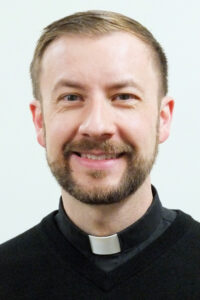Q: When I pray the Angelus, before the third Hail Mary, as I say, “And the word was made flesh and dwelt among us,” I often find myself gently striking my breast. Is this correct?

A: To my knowledge there is no rubric or custom of striking the breast as we recite this verse (John 1:14) as part of the Angelus prayer. It is customary to bow one’s head at this line. It could be that you picked this up from your family or other Catholics. However, the gesture is not without precedence.
There are times when we are instructed in the liturgy to strike our breast, albeit in a different context. At Mass when we use the first form of the Penitential Act called the Confiteor (for the first word in the Latin prayer meaning “I confess”), the faithful are instructed to strike their breast at the words, “through my fault, through my fault, through my most grievous fault.”
Interestingly, the rubrics say nothing about the number of times a person is to strike his or her breast but most people instinctively do so three times. The rubrics also say nothing about how precisely one is to do this, whether open-handed or close-fisted, or how hard. Occasionally, I have seen some people forcefully strike their breast with a fist, hard enough to hear the thump. In my opinion, this is a little overkill for a gesture that is simply meant to signify repentance, not corporal punishment, and it calls more attention to the person than to God’s mercy.
The other instance I can think of when someone is instructed to strike his or her breast is for the priest during the first Eucharistic Prayer (the “Roman Canon”). This happens towards the end of the prayer when he says, “To us, also, your servants, who, though sinners, hope in your abundant mercies….”
I have also seen people strike their breast three times at the end of the prayer “Hail, Holy Queen,” when they say, “O clement, O loving, O sweet Virgin Mary,” but it is neither prescribed nor forbidden.
In summary, I don’t think it is wrong that you do this but it is also not necessary. It has obviously developed as a part of your own piety, which is a beautiful thing. If doing this makes you think more about the mystery of Our Lord’s incarnation, then by all means keep it. If, on the other hand, it distracts you from that mystery and makes you think more of yourself or your own piety, then I would drop it.
One of the things I love about being Catholic is that we pray with our whole bodies!
Q. Do Catholics ignore the Old Testament when teaching doctrine?
A. The short answer is, “no.” If we did, then we probably would not have included the Old Testament in the accepted canon of Sacred Scripture. There was a heresy in the early church (Marcionism) where some wanted to do this but it did not prevail, thankfully. If you pick up your Bible at home, you might notice that most of it is the Old Testament. We believe the Bible in its entirety to be the inspired word of God.
At the same time, the Church interprets the Old Testament in light of the coming of Christ and what we believe is the definitive fulfillment of God’s covenant with humanity. There are many practices that can be found in the Old Testament that we no longer observe but fundamentally we believe what our Jewish brothers and sisters believe about God and we follow Jesus of Nazareth, who himself was a Jew.
(Father Thom Hennen serves as the pastor of Sacred Heart Cathedral in Davenport. Send questions to messenger@davenportdiocese.org)










